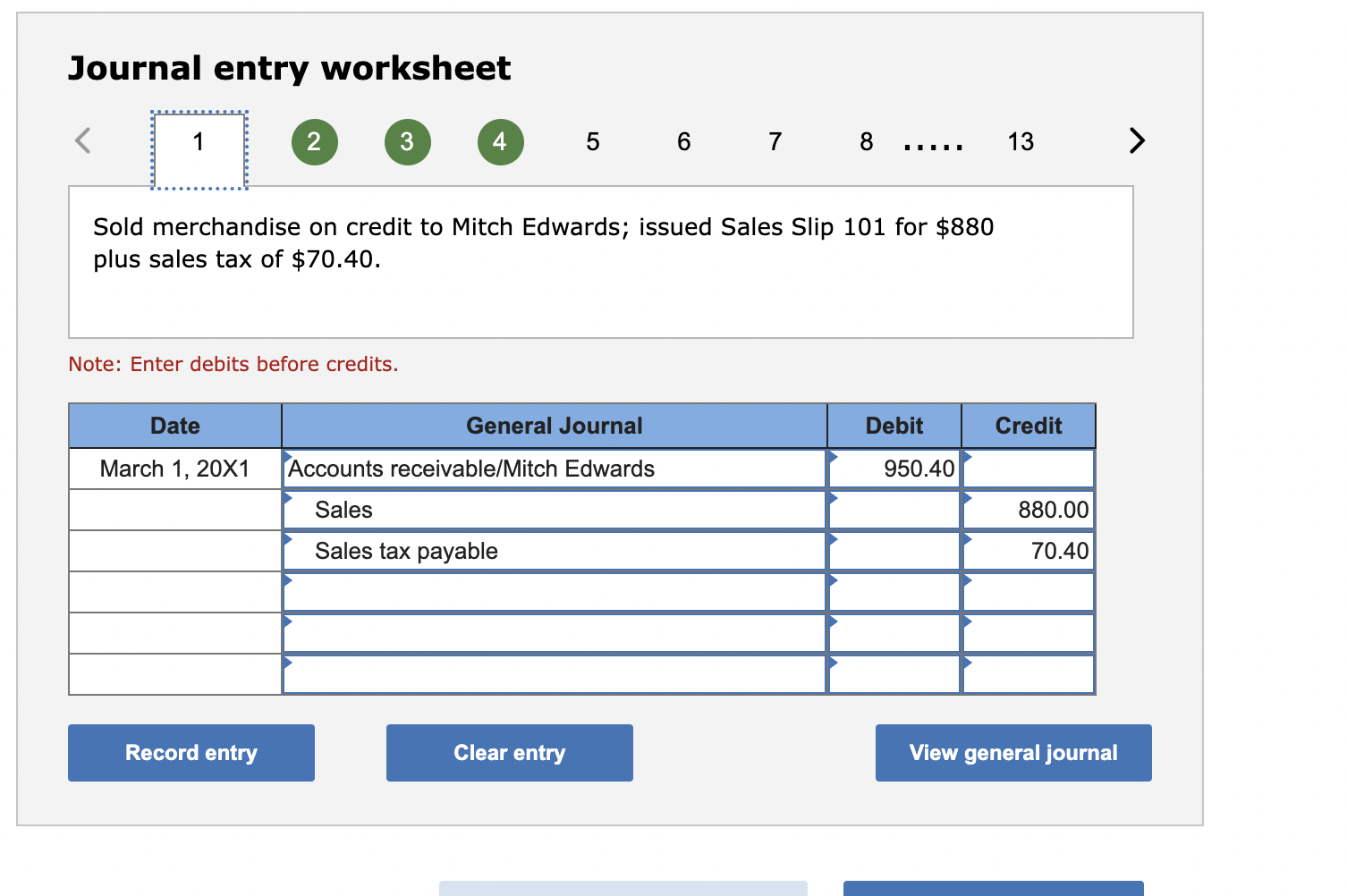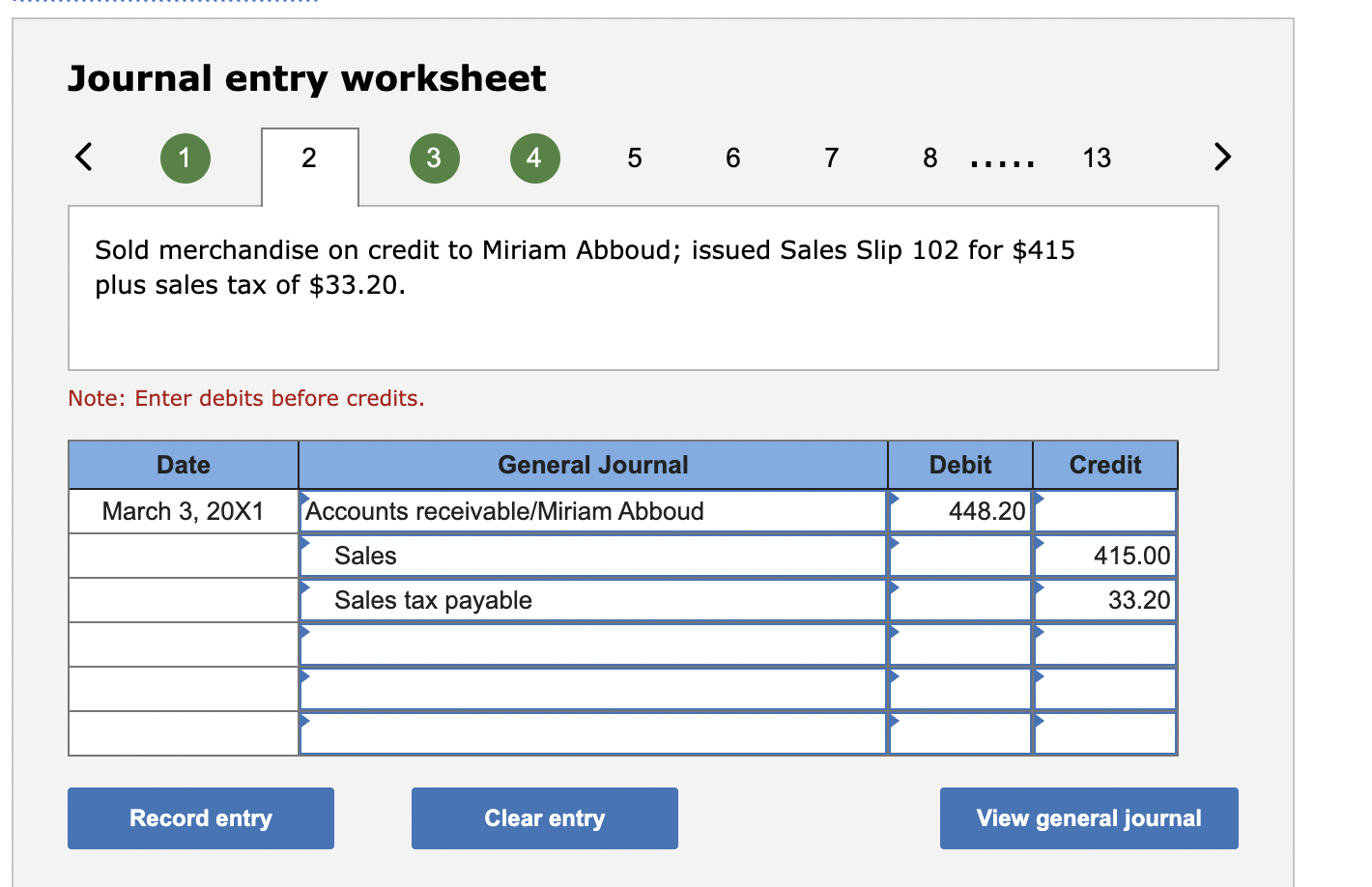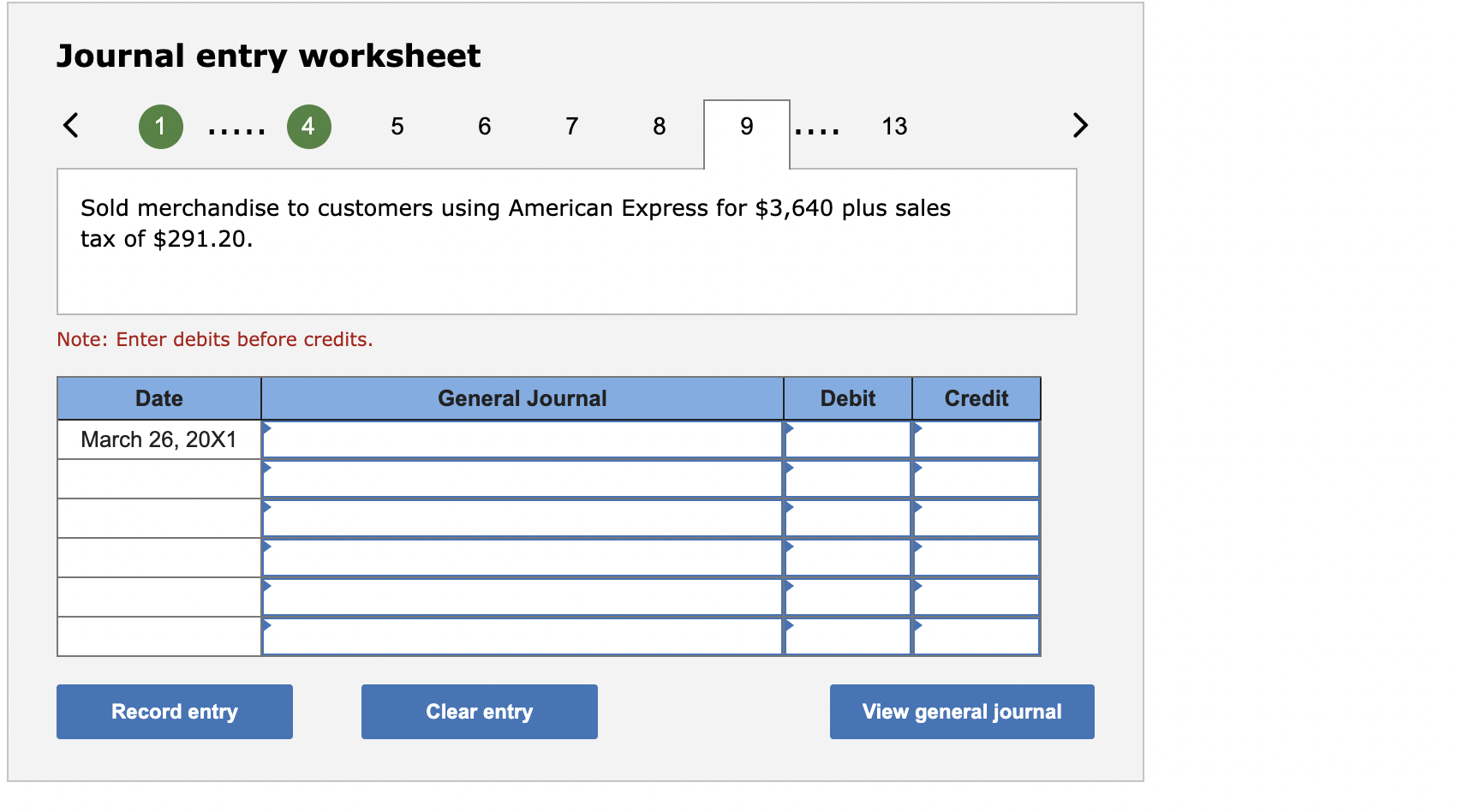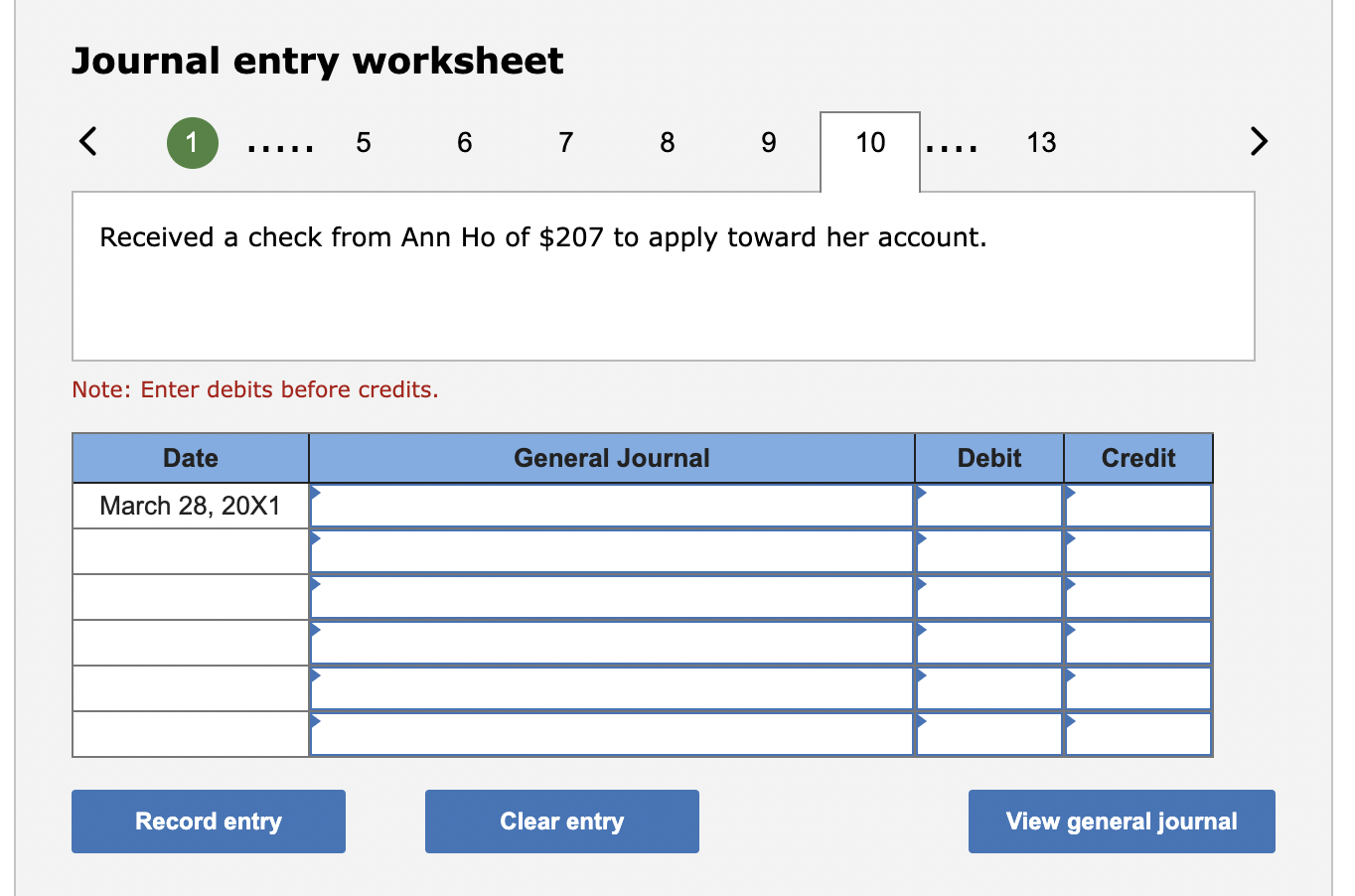

















Sports Junction began operations March 1, 20X1. The firm sells its merchandise for cash; on open account; to customers using bank credit cards, such as MasterCard and Visa; and to customers using American Express. Merchandise sales are subject to an 8 percent sales tax. The bank credit cards charge a 3 percent fee. American Express charges a 4 percent fee. During March, Sports Junction engaged in the following transactions: DATE TRANSACTIONS 201 March 1 Sold merchandise on credit to Mitch Edwards; issued Sales Slip 101 for $880 plus sales tax of $70.40. 3 Sold merchandise on credit to Miriam Abboud; issued Sales slip 102 for $415 plus sales tax of $33.20. 8 Accepted a return of merchandise from Mitch Edwards; the merchandise was originally sold on sales slip 101 of March 1; issued Credit Memorandum 1 for $215, which included sales tax of $15.93. 10 Received payment from Mitch Edwards in payment of his balance owed for merchandise sold on March 1 , less the return of merchandise on March 8. 12 Sold merchandise on credit to Ann Ho; issued Sales Slip 103 for $605 plus sales tax of $48.40. 15 Recorded cash sales for the period from March 1 to March 15 of $5,400 plus sales tax of $432.00. 15 Recorded sales for the period from March 1 to March 15 to customers using bank credit cards of $400 plus sales tax of $592.00. (Record the 3 percent credit card expense at this time.) 25 Sold merchandise on credit to Frank Canzetti; issued Sales Slip 104 for \$540 plus sales tax of $4.20. 26 Sold merchandise to customers using American Express for $3,640 plus sales tax of $291.20. 28 Received a check from Ann Ho of $207 to apply toward her account. 31 Recorded cash sales for the period from March 16 to March 31 of $5,900 plus sales tax of $472.00. 31 Received payment from American Express for the amount billed on March 26 , less a 4 percent fee. 31 Recorded sales for the period from March 16 to March 31 to customers using bank credit cards of $6,650 plus sales tax of $532.00. (Record the 3 percent credit card expense at this time.) Required: 2. Record the transactions in a general journal. 3. Post the entries from the general journal to the appropriate account in the general ledger and in the accounts receivable ledger. 4. Prepare a schedule of accounts receivable. GENERAL LEDGER ACCOUNTS Complete this question by entering your answers in the tabs below. Record the transactions in a general journal. (Round your answers to 2 decimal places.) Journal entry worksheet Sold merchandise on credit to Mitch Edwards; issued Sales Slip 101 for $880 plus sales tax of $70.40. Note: Enter debits before credits. Journal entry worksheet Sold merchandise on credit to Miriam Abboud; issued Sales Slip 102 for $415 plus sales tax of $33.20. Note: Enter debits before credits. Journal entry worksheet Accepted a return of merchandise from Mitch Edwards; the merchandise was originally sold on Sales Slip 101 of March 1; issued Credit Memorandum 1 for $215, which included sales tax of $15.93. Note: Enter debits before credits. Journal entry worksheet 1 8 Received payment from Mitch Edwards in payment of his balance owed for merchandise sold on March 1 , less the return of merchandise on March 8. Note: Enter debits before credits. Journal entry worksheet 1 2 13 Sold merchandise on credit to Ann Ho; issued Sales Slip 103 for $605 plus sales tax of $48.40. Note: Enter debits before credits. Journal entry worksheet 2 8 Recorded cash sales for the period from March 1 to March 15 of $5,400 plus sales tax of $432.00. Note: Enter debits before credits. Journal entry worksheet 2 3 813 Recorded sales for the period from March 1 to March 15 to customers using bank credit cards of $7,400 plus sales tax of $592.00. (Record the 3 percent credit card expense at this time.) Note: Enter debits before credits. Journal entry worksheet Sold merchandise on credit to Frank Canzetti; issued Sales Slip 104 for $540 plus sales tax of $43.20. Note: Enter debits before credits. Journal entry worksheet 1 4 6 7 13 Sold merchandise to customers using American Express for $3,640 plus sales tax of $291.20. Note: Enter debits before credits. Journal entry worksheet ( .5 Received a check from Ann Ho of $207 to apply toward her account. Note: Enter debits before credits. Journal entry worksheet (1) ,6 13 Recorded cash sales for the period from March 16 to March 31 of $5,900 plus sales tax of $472.00. Note: Enter debits before credits. Journal entry worksheet (1) ,6 13 Received payment from American Express for the amount billed on March 26, less a 4 percent fee. Note: Enter debits before credits. Journal entry worksheet ( ..6 Recorded sales for the period from March 16 to March 31 to customers using bank credit cards of $6,650 plus sales tax of $532.00. (Record the 3 percent credit card expense at this time.) Note: Enter debits before credits. Complete this question by entering your answers in the tabs below. Post the entries from the general journal to the appropriate account in the general ledger and in the accou places.) ACCOUNTS RECEIVABLE SUBSIDIARY LEDGER Complete this question by entering your answers in the tabs below. Prepare a schedule of accounts receivable
























